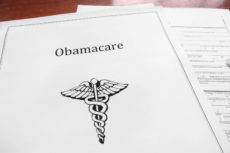Almost All Increase in Health Coverage Due to Return of Benefits
 The best measurement of people who lack health insurance, the National Health Interview Survey published by the Centers for Disease Control and Prevention (CDC), has released early estimates of health insurance for all fifty states and the District of Columbia in the first quarter of 2016. There are three things to note.
The best measurement of people who lack health insurance, the National Health Interview Survey published by the Centers for Disease Control and Prevention (CDC), has released early estimates of health insurance for all fifty states and the District of Columbia in the first quarter of 2016. There are three things to note.
First: 70.2 percent of residents, age 18 to 64, had “private health insurance” (at the time of the interview) in the first quarter of this year, which is the same rate as persisted until 2006. Obamacare has not achieved a breakthrough in coverage. It has just restored us to where we were a decade ago. Further, the contribution of Obamacare’s exchanges to this recovery is almost trivial, covering only four million people.
What has really happened is a restoration of employer-based benefits as we have slowly clawed our way out of recession: 61.2 million people had non-exchange private insurance in Q1 2010. This included both employer-based benefits and the pre-Obamacare market for individual health insurance. By Q1 2016, this had increased to 66 million. Because most in the pre-Obamacare individual market have shifted into Obamacare exchange coverage, the increase in employer-based coverage would be close to eight or nine million.
Second: There has been a significant change from private coverage to government welfare (primarily Medicaid). The shift has been about five percentage points since 2006, and ten percentage points since 1997. Critics of Obamacare who focus on its increasing the proportion of people dependent on Medicaid (a welfare program) ignore the great expansion of Medicaid dependency years before anyone had heard of Barack Obama.
Third: There is a significant discrepancy between the four million Obamacare beneficiaries estimated by the NHIS and estimates produced by the U.S. Department of Health & Human Services and the Congressional Budget Office, which estimate about 11 million Obamacare beneficiaries.
The only plausible explanation for the discrepancy is that the NHIS’s four million beneficiaries are people who had Obamacare exchange coverage at the time of the interview, whereas the other estimates must be estimating the number of people covered through an Obamacare exchange at any point in the year.
Obamacare policies are unpopular: Enrollment peaks in the third quarter and there is a significant drop off in the fourth quarter. People want jobs with benefits, not Obamacare, which has mostly served to fragment health coverage even more, rather than actually expand coverage.
* * *
For the pivotal alternative to Obamacare, see John C. Goodman’s widely acclaimed Independent Institute books, Priceless: Curing the Healthcare Crisis, and A Better Choice: Healthcare Solutions for America.


















